We’re moving right along in the BBA Challenge. I finally made it to the bread on the cover of the Bread Baker’s Apprentice book: Poilâne-Style Miche (#33). Poilâne Miche is a naturally fermented country bread created by Lionel Poilâne, a famous baker in Paris. He calls his bread a miche but it is referred to as Pain Poilâne by others. Poilane has a very unique (and interesting) system for making his bread and his apprentices are specially trained in the craft.
My goal was to create a reasonable facsimile of this bread in my kitchen. I liked the way the bread looked on the cover but wasn’t sure how it would taste or if I could recreate it in a manner worthy of it’s fame; particularly given my not so pleasant results with the Sourdough Rye/Spelt Bread. I was pleasantly surprised. It’s a beauty! It is a somewhat dense and chewy bread, but the flavor is really good.
Since I’m pleased with how my Poilâne-Style Miche turned out, I decided to submit it to YeastSpotting, a weekly bread roundup hosted by Susan of Wild Yeast. Please visit Wild Yeast to view all of the lovely breads in the roundup.
Poilâne-Style Miche
I had fun making this bread. It is made with whole wheat flour that is sifted to a partial whole wheat, a 90 to 95 percent extraction rate (which, according to Peter Reinhart, means that much, but not all, of the bran is still in the flour). I used freshly milled organic red winter wheat and was able to extract a good bit of the bran because home-milled flour is coarser than commercially-milled whole wheat flour and the bran separates more easily.
Ingredients:
Firm Starter
- 7 oz (1 cup) sourdough starter
- 9 oz (2 cups) sifted medium-grind whole wheat flour
- 4 oz (about 1/2 cup) water, at room temperature
Final Dough:
- 32 oz (7 cups) sifted medium-grind whole wheat flour
- .81 oz (3 1/4 tsp) salt (or 2 T coarse sea salt or kosher salt)
- 18 to 22 oz (2 to 2 1/4 cups) water, lukewarm (90 degrees to 100 degrees F.)
- Semolina flour or cornmeal for dusting
This is the sifted home-milled flour. See all the bran that’s left after the flour is sifted out. This process is way cool!
Directions:
The day before you want to make this bread, make a firm starter with a mixture of sifted medium-grind whole-wheat flour, water and barm (or mother starter) that has been fed.
Mix until it forms a ball, then transfer the dough to the counter and knead the mixture for about 3 minutes until all the flour is hydrated and the ingredients are evenly distributed.
Place the dough in a lightly oiled bowl and roll it around in it to coat it with the oil. Then cover the bowl with plastic wrap and let the dough ferment at room temperature for 4 to 6 hours, or until the dough doubles in size. Then refrigerate it overnight.
The next day, remove the starter from the refrigerator 1 hour before making the dough.
Cut the starter into about 12 small pieces with a pastry scraper. Cover the dough pieces with plastic wrap and let them sit for 1 hour to take off the chill.
Stir together the sifted whole-wheat flour (all 7 cups of it), salt, and starter pieces. A Danish dough whisk works really well for this part but you can also use a large metal spoon.
Add enough water to bring all of the ingredients into a soft ball. Adjust the flour and water as necessary.
Next, sprinkle some flour on the counter and get ready to knead it and I mean knead it. I hope you’ve been working out because this is the tough part. The dough is way too heavy for most stand mixers so you have to do this by hand and it takes about 12-15 minutes.
I put on some music and got a good workout with this one. I didn’t take pictures of that part. 😉
The dough should be supple and tacky but not sticky. Lightly oil a large bowl and place the dough inside, rolling it around to coat it with oil. Cover the dough with plastic wrap and let it ferment at room temperature for approximately 4 hours, or until the dough nearly doubles in size. I let it sit for about 5 hours I think.
Transfer the dough to the counter and form it into a boule.
Proof the dough in a banneton (if you have one) or do what I did and use a large bowl covered with a cloth that has been sprayed with spray oil and sprinkled generously with flour. The bowl should be big enough to hold the dough when it rises to nearly double in size. My bowl may have been a little bit too big but it worked just fine.
Place the dough seam side up, in the bowl and mist the top with spray oil.
Cover with a cloth or plastic wrap. I opted for plastic wrap. Proof the boule at room temperature for 2 to 3 hours, or until the dough grows 1 1/2 times in size.
Prepare the oven for hearth baking. For my oven, this means placing a baking stone on the middle rack and a steam pan on the bottom rack. If I put the baking stone any lower, then the bread burns on the bottom. Preheat the oven to 500 degrees F.
Carefully remove the top layer of cloth or plastic wrap from the dough 10 minutes before baking. Dust the back of a peel with semolina flour or cornmeal. I used cornmeal.
Turn the dough out gently onto the peel and carefully remove the cloth liner from the dough.
S
core the dough with a large pound sign.
Slide the dough onto the baking stone. Pour 2 cups of hot water into the steam pan and close the door. Immediately lower the temperature to 450 degrees F.
After 25 minutes, rotate the loaf 180 degrees and lower the oven setting to 425 degrees F. And to think, the Poulane bakers have to do this by feel; they don’t have thermometers on their ovens. Continue to baking for another 30 to 40 minutes, until the bread is done. It should be deeply browned. It’s a beautiful color!
Transfer the loaf to a wire rack and let it cool for at least 2 hours before slicing or serving.
This bread tastes great warm or toasted with butter. Store the bread in a brown paper bag. It will keep for about 5 to 7 days. I made it last Saturday and the bread still tastes pretty good (on Wednesday). Just serve it warm with butter. I haven’t tried this yet, but I think it would also taste great with cheese and meat.
I didn’t get a shot of the crumb. I was so proud of the shot of the loaf, I forgot to take a picture when we sliced it. Oops!
Thanks for joining us this week in the Bread Baker’s Apprentice Challenge.
The next bread in the Bread Baker’s Apprentice Challenge is Pumpernickel Bread. I liked that one too. I’ll be posting about it soon.
Happy Baking!
Cathy
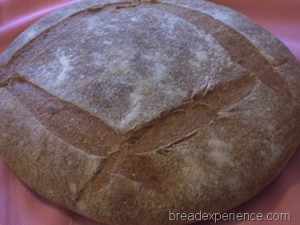
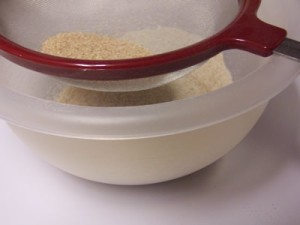
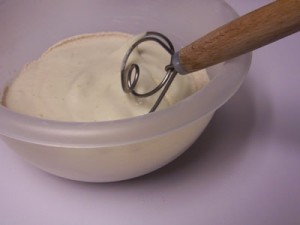
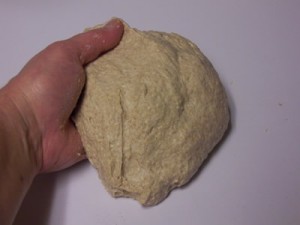
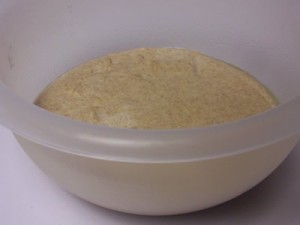
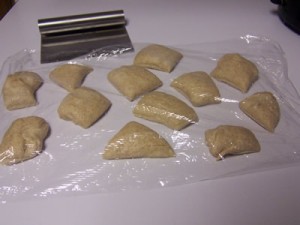
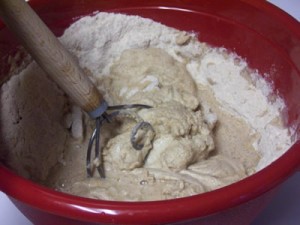
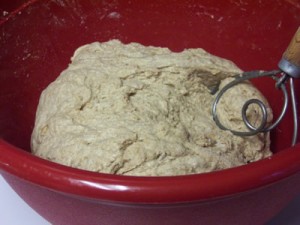
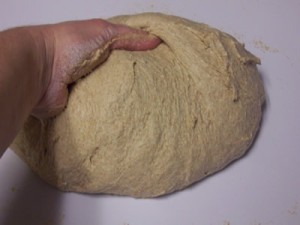
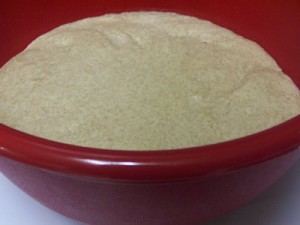
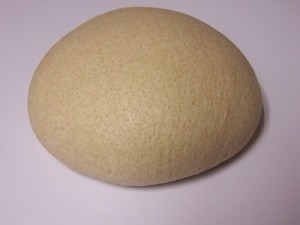
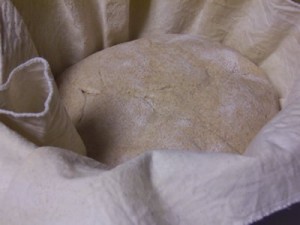
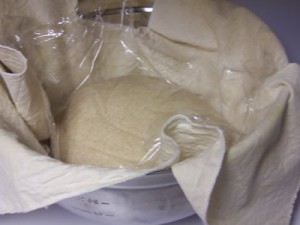
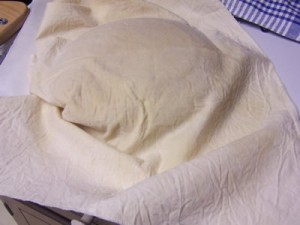
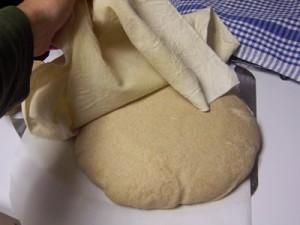
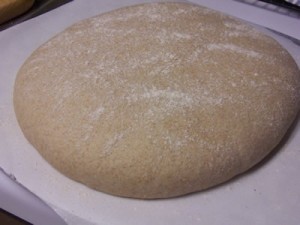
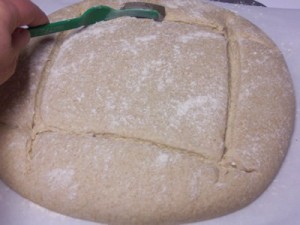
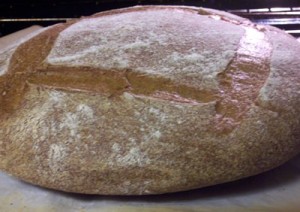
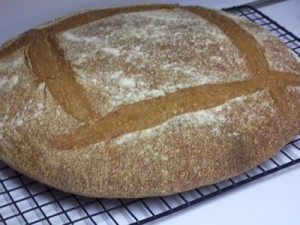
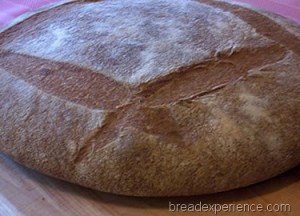
TeaLady says
beautiful. Looking forward to making this one.
ATigerinTheKitchen says
VERY beautiful!! It looked exactly like the one on the cover of the book! Congrats…
Cathy (breadexperience) says
Thanks! I enjoyed making this one. You will too!
Anonymous says
Hi Cathy,
Very nice looking Miche…you have to love wet doughs! How was the crumb?
Cheers,
Judd aka Captain Batard
Cathy (breadexperience) says
Hi Judd! Thanks for stopping by! The crumb was pretty good. Forgot to take a picture of that part of the process.
Rosemary & Garlic says
Cathy, your loaf looks superb.
Cathy (breadexperience) says
Thank you Ann Marie! I had fun with this one.
pragmaticattic says
Great job–I understand that this bread is a real challenge, and your bread looks fab. Nice photo tutorial, too.
Cathy (breadexperience) says
Thanks! I actually had fun with this one. The one before it was a challenge for sure.
Cristie says
The loaf is beautiful. Thanks for the picure of the slashing- it looks so perfect!
Mags says
I was hoping to see a picture of you cradling the loaf in your arms (like the book…lol)
Great job on this one. Looks perfect!
Cathy (breadexperience) says
Thanks Cristie! I think I’m finally getting the hang of slashing.
Cathy (breadexperience) says
Thanks Mags! I had toyed with the idea of getting a photo of me with the bread, but decided not to. I thought it looked good on its own. 😉
Rosemary & Garlic says
I’m for mandatory loaf cradling:)
Anne Marie
Cathy (breadexperience) says
Sorry to disapoint. There wasn’t anyone around last weekend to take the photo. Maybe next time.
Joanne says
This loaf is so very very beautiful! I love a good poilane.
Cathy (breadexperience) says
Thank you Joanne. I really enjoyed this one. It’s a keeper!